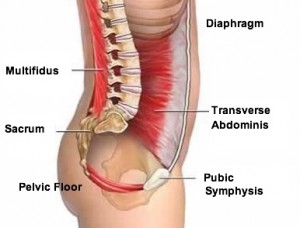The Myth About Core Training.
Core training is easily mistaked as the training of the abdominal muscles that give you the illusion of having a six-pack torso. Hence, many people chasing that illusion do countless repetitions of abdominal crunches, sit-ups or whatever exercises they think would get them there. But they are wrong. It's a whole different story of weight loss and how there is this layer of abdominal fat lying over the abdominal muscles which needs to be burnt off before the outline of the abdominal muscles can be seen.

Who says ladies can't have abs? Tamaryn Venter thinks otherwise.
Thus, you may start to wonder.. "So what's really core training?" To really understand this, we need to know how the core works and what the purpose of it is.
The core is technically made of:
- Abdominal muscles (both the abs and the obliques on the side)
- Back extensor muscles (the ropey muscles that run down your spine)
- Diaphragm (the muscle that helps you breathe and the only muscle we have no control)
- Pelvic floor (the imaginary floor that holds your floodgates in).
These muscles form almost a solid cube/ball/box structure that holds your organs in place and simultaneously stabilises your spinal column. Hence, by activating the core musculature, you create a really solid position in your torso that supports your spine.
So with that, the core is meant to be a stable element in your body and during your movements. This has also been shown in studies where they have done electromyographic (EMG) on the core musculature and discovered that the muscles in the core are the first to fire off no matter what movement you are doing (e.g throwing a ball, or even just raising your arm!).
Therefore, the core should be trained in stability and not movement. As in a recent article by Dr Stuart McGill (guru in back injuries), he mentioned that the core is a stabilizer than a movement generator. Only when the core is stable, movements in the extremities become more efficient and effective, resulting in a better outcome of the movement. This simply means if the core is stable, the movement becomes more efficient due to the ability to add up the forces generated in the relevant sequence.
For example, in a throw, the rotation of the hips creates torque that gets transferred through the torso then into the shoulders and lastly to the arms and fingers to be transferred to the object being thrown. Should the core be unstable, this transference of torque would be inefficient and the end result of throwing the ball will not be as effective. In extreme cases, the force transferred into the torso could even cause injury should there be unnecessary movement in the spine.
Therefore, when you think about core training now, always think of the core being a solid piece! Then you can start understanding what core training is. Core training is to work the core in stability or in other words, the core needs to learn how to be stable whether in a stationary position or in movement. Hence, there are two main categories of core training: static or dynamic core training.
Static Core Stabilization
As the name suggests, this means the core is trained in a fixed position with no external movement of the body. This would involve the positions which the core is trained to hold itself in position. These would be in the form of your plank/hover movements, both prone or lateral holds. These sort of exercises help train the core to keep a stable position and allows you to concentrate on activating the musculature for stability.
Dynamic Core Stabilization
This is a continuation of static core stabilization where after the muscles of the trunk are kept in a position of stability, external movement is now added to add perturbations to the core to further enhance the training stimulus. For example, a cable walkout (where you hold the cable pulley and walk sideways aways from the pulley) engages the core at the start in a stationary position and when movement is added, targets the core in a dynamic movement. Hence, dynamic core stabilization involves any additional movement of the extremities to keep the core stable while in movement.
So with that, you can easily come up with a simple core program of both static and dynamic core stability exercises which will probably take about 15-20 minutes to complete. The key to core training is to keep it simple and not overcomplicate it. Holding a plank position and then adding movement of the feet side to side in the same position will do you more wonders than countless crunches and sit-ups!
Stay Strong and Keep Working Your Core,
The Training Geek.

